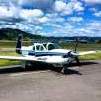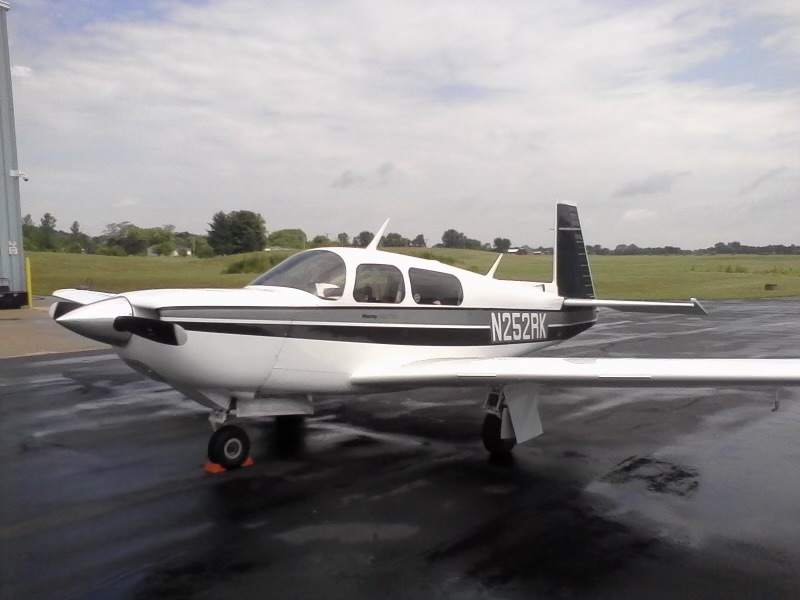-
Posts
5,463 -
Joined
-
Last visited
-
Days Won
25
Content Type
Profiles
Forums
Blogs
Gallery
Downloads
Media Demo
Events
Everything posted by Ragsf15e
-

Mooney Factory Annual Inspection
Ragsf15e replied to FAST FLIGHT OPTIONS LLC's topic in General Mooney Talk
I want to say maybe @LANCECASPER used them for something too? -
Just remember all this talk of stall speed at 60 degrees of bank assumes level, unaccelerated flight. To feel this, go up and do steep turns. No wait, PPL steep turns are only 45 degrees. Do 60 degree steep turns at say Va. It will require a lot of power addition and a firm pull to maintain level flight. You will definitely feel the 2 Gs. Yes, in that condition, stall speed is ~40% higher. At less than 2 Gs, the stall speed is much less. As @aviatoreb said, it’s AOA that matters. Doing steep turns and slow flight and stalls and turning stalls are all very good for us. Remember, I can easily fly 90 degrees of bank and 50mph and not be stalled. I will be at less than 1 G and nose will be falling. I can do 60 degrees bank at 75 and not stall. Really easy to prove to yourself at altitude. Before I get flamed for suggesting 90 degrees bank and 50mph in the pattern, I’m not suggesting that. We just need to remember these relationships (academically), practice them at altitude (skill), and apply them in our flying (combination + experience). A good instructor can help.
-
Depending on where you’re having it done (or doing it yourself), that may be part of the job. There’s a gasket on both sides of the interior under pilot/passenger knee area. If it’s all open and the experts are doing it, I’d definitely change that. However, it can be done outside of a full tank reseal. Another consideration is for new or overhauled level senders since it’s all open. Depending on your fuel gages, CIES makes far superior fuel level sensors than our original. However, if you keep the originals, overhauling them is also an option.
-
Well 2 things… Fighter pilot stories only require 10% truth, so either way we’ve met that threshold… Second, you can probably successfully eject with your lap belt undone. The lapbelt is part of the seat and is separated at some point during ejection before you separate from the seat. Shoulder harness and crotch straps are part of the chute. You need those. Ejection is like a simple 27 step process. Actually I know of at least two other pee/ejection scenarios. One was on the ground. Both lived.
-
Yeah, the PA-46T I manage has one too. Picture an aircraft pressurized to 9,000’ but flying at 25,000’. When you squeeze the little handle to open the valve on the funnel, pressurized air shoots out through the funnel causing a cold breeze. It’s not ideal. Well, that and the POH warning about severe corrosion risk of urine, so the pilot has to dump like 2 gallons of baking soda/water through the thing immediately after the flight. I like bags better, but basically, I just hold it.
-

Just recently bought my first airplane. A Mooney M20E
Ragsf15e replied to mluster's topic in General Mooney Talk
Awesome job “flying it all the way through the crash!” (That’s Bob Hoover advise…). So glad you kept the airplane flying and chose a good spot! Great job considering the gear but not second guessing yourself either. Turned out great! Hopefully someone can look at the throttle linkage and see what failed. I think the actual cable to throttle uses a castle nut and cotter pin. Most importantly… If it was your wife with you (reference from your earlier posts), will she let you buy another plane and fly with you again? -

Just recently bought my first airplane. A Mooney M20E
Ragsf15e replied to mluster's topic in General Mooney Talk
Definitely glad everyone is ok. Nice job getting it down under control and survivable. Hopefully @mluster can come back here and let us know what happened so we can all learn. -
So you must have been ROP with that ff at 10,000’, and it just went cold? Seems pretty blocked. Probably a little exciting. Did you know exactly what it was at the time?
-
Don’t do 3 without 4 and vice versa. I would fly it for a year as is myself and then go big for 3/4 once you’re really sure.
-

JPI voltage readings bounce around...?
Ragsf15e replied to joepilotmooney's topic in Modern Mooney Discussion
Is it actually showing 12.5ish? That’s real low. Like, does it charge your battery?? Heres a quick check… take a digital volt meter next time you fly. Measure voltage on the bus bar behind all the breakers (bus bar to ground). It should be 14.0. Either way, I’d work on finding the problem as @LANCECASPER suggested, but if it’s really 12.5, you might want to work on it with some haste… You can also measure at the cigarette lighter if you want. This doesn’t mean the battery is getting full voltage, but it’s a place to start. -

Anyone own a 1977 or 1978 M20C?
Ragsf15e replied to Evan Amaya's topic in Vintage Mooneys (pre-J models)
Looks great! Are those gi-275s below/right of the adi? I imagine one is typically on as HSI? -

TKS and IFR people. What is your procedure?
Ragsf15e replied to r0ckst4r's topic in Modern Mooney Discussion
Either heated wings or “nonstick” paint. I’d love to see more deice solutions, but doubt it will happen. GA just isn’t big enough. There is a cool (experimental/non fiki) deice system that electrically heats the leading edges on a cycle. It requires a separate alternator. I’ve seen it on an RV. -

TKS and IFR people. What is your procedure?
Ragsf15e replied to r0ckst4r's topic in Modern Mooney Discussion
Ha! There’s a whole thread on B-talk about how much of a PIA boots are to strip / clean / care for. Someone on there said they love the TKS because it’s easy to use and keep in good shape. We all just need heated wings! -

M20J Alternator Field Circuit Breaker Pops
Ragsf15e replied to Jack46's topic in Modern Mooney Discussion
Additionally ( I’m nowhere near as good at this as skip), but some aftermarket VR (like zeph) may have the sense line but not need it hooked up depending on how the original airplane is wired. So it can be confusing when you read about the vr having that circuit but it’s not connected? -

Mooney down, no injuries Ocala
Ragsf15e replied to Eight8Victor's topic in Mooney Safety & Accident Discussion
I hope that’s true, but the more formal investigation and data published by the ntsb gives me more confidence that someone gets to the bottom of it. How do we get to the fsdo data? -

Mooney down, no injuries Ocala
Ragsf15e replied to Eight8Victor's topic in Mooney Safety & Accident Discussion
While I don’t wish an investigation on the aircrew, it would actually be nice if these “minor” ones resulting from loss of power were investigated. The airplane is in perfect condition and the aircrew are alive for interviews. It should be really easy to determine cause and get us better statistics/safety. When the loss of power is at night/imc and the same airplane impacts a hillside at high velocity, the resulting investigation takes a long time and is much more difficult to find the cause. -
The F-16 guys have to make instructional videos about using a piddle pack so they don’t lose control of the aircraft again. And again. Very embarrassing. And lest you don’t believe me… https://www.latimes.com/archives/la-xpm-1991-03-23-me-542-story.html and https://www.deseret.com/1993/10/28/19073421/18-million-fighter-jet-is-lost-as-pilot-heeds-nature-s-call?_amp=true
-
I just donated too. Sorry it took me a while this year. Thanks for upgrading!
-
From what you’re saying, I think your alternator and VR are probably fine. However, you have a corroded connection or some other resistance between the alternator and where the jpi picks up the voltage. On a properly functioning system, there’s no voltage drop between the alternator, power bus, avionics bus, aux bus and all the way back to the battery. However, after 55+ years it’s easy to get a little corrosion and that’s enough to increase resistance. It probably won’t hurt anything but keep an eye on it to catch it if it falls further.
-
Sad for the warblers, but happy you found just the right sized guys to end up with zero damage! I’ve see a hole through a leading edge of an Air Force plane, F-15E downed by a vulture, and a pelican took out a C-172 and killed 3 people in Eastern Washington (nowhere near the ocean). Good job going through the process.
-
Hopefully yours is fixed with the new part. If not, take your time. Good luck!
-
The contacter and up/down limit switches cause strange issues. A little lps 1 and exercising the limit switches causes weird fixes.
-
A good place to start looking for added resistance is at your ground attached from the battery to the airplane. So first (everything off), check bat voltage at the battery with a dvm. Then battery (pos) to the airframe (neg). They should be almost exactly the same. Then with master power on, check battery and then power bus which is behind the circuit breakers. The zeph guide takes you through a few more steps. I didn’t find my issue until I started the airplane and followed the 14v out of the alternator until it dropped to 13.5 through one bus connection at a circuit breaker. I would say these are difficult to locate but cheap to fix.
-
I don’t have the same take on voltage. However, I’m no EE either… your alternator should sit at 14+\-.1 regardless of if your battery is fully charged. Your vr should keep the electrical system at that same 14+/-.1. Mine definitely does on my edm930. While the battery is charging, the amps indication on the 930 indicates higher amperage to the battery - which is all the amp meter measures for most of us, current to/from the battery. However, the voltage doesn’t change when the battery is “topped off”. The VR keeps it at 14. If you’re showing 13.6 or so in flight, you’ve got some resistance somewhere in your system. Probably a corroded connection and easy to fix once found. I had similar and traced voltage back from the alternator until I found it (couple years ago). Sanded the connectors, 14v steady ever since. I bet if you start the engine and let it idle but then check the output from the alternator with a dvm and alligator clip wires, you’ll see the alternator is putting out 14v. Your system is losing it somewhere along the way. zephtronics has a low voltage troubleshooting guide for less than 13.9V.
-
While I agree that it would be better to do your first one in the shop on jacks, my first one was in my transition training too. And it also went horribly wrong. The “Mooney” cfi kind of guessed how to go through the exercise, and I didn’t know any better. We followed the checklist and got the gear down, but there’s no checklist to get it back up. We failed to disengage the manual crank and it spun real fast backwards when we engaged the motor up. Could have destroyed my knee and destroyed the manual system. I got lucky and no damage. The Mooney manual backup system may not be perfect in every failure. It seems most applicable to a loss of electrical power to the gear motor. In that case, it works really well. If somehow your electric motor is jammed/seized, the backup is likely useless. I’m not saying that happens, but the manual system just manually actuates the primary system. Let us know what you find out.



